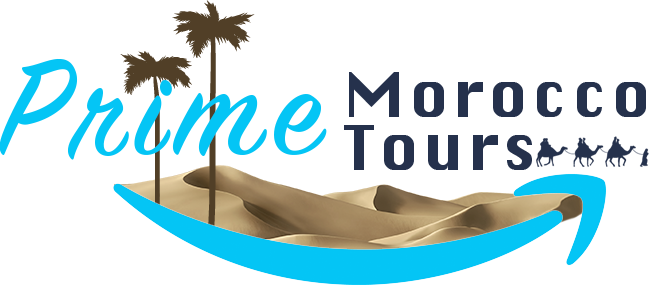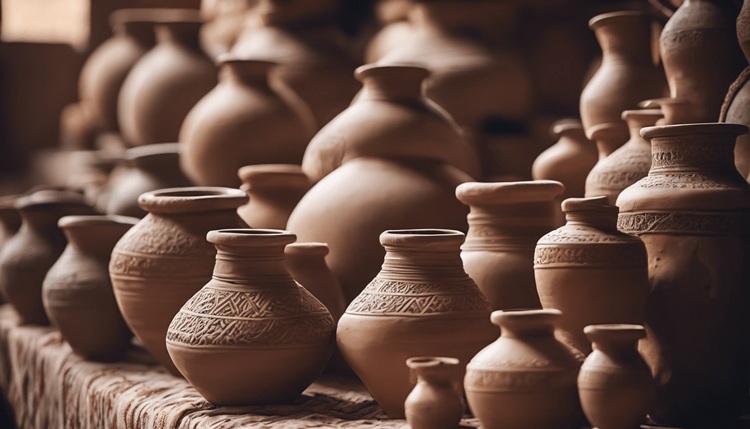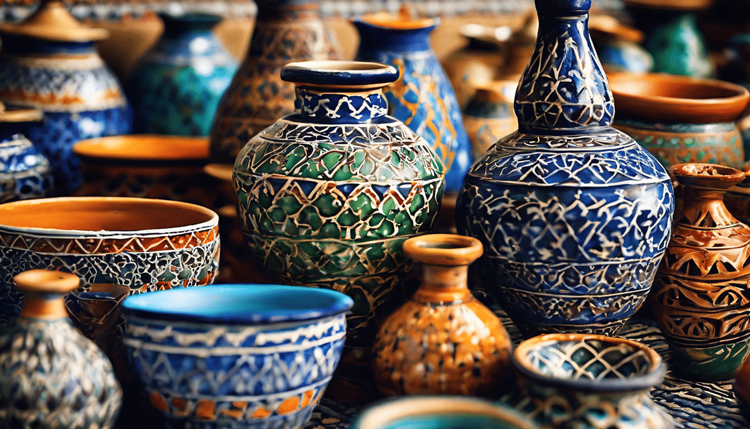Modern Morocco: A Fusion of Tradition and Contemporary Tourism
Morocco is a country with a rich heritage of craftsmanship, where artistic expression is embedded in the daily life of its people. Among the most celebrated forms of Moroccan artistry are its mosaics and pottery crafts. These traditional arts are not just decorative, but they also carry deep cultural significance, passed down through generations, reflecting the country’s history, spirituality, and sense of community.
1. Moroccan Mosaic Art: Zellige
Moroccan mosaics, known as Zellige (or Zellij), are one of the most recognizable and defining elements of Moroccan architectural design. These intricate and colorful mosaics are made up of small, hand-cut pieces of glazed terracotta tiles, carefully arranged to form geometric patterns. Zellige has been used for centuries to adorn mosques, palaces, fountains, and homes, creating breathtaking walls, floors, and columns.
A History Rooted in Islamic Art
Zellige is deeply rooted in Islamic art traditions, where geometric patterns are highly valued for their spiritual symbolism. Islamic art often avoids the depiction of living creatures, and instead, focuses on complex patterns that represent the infinite nature of Allah’s creation. In Morocco, Zellige became popular during the Almohad Dynasty (12th century), and its use expanded during the Merinid Dynasty (13th to 15th centuries), when it flourished in cities like Fes and Marrakech.
The craft has remained largely unchanged over the centuries, continuing to symbolize the unity and precision of Islamic art. Many of the traditional designs are based on Islamic geometry, employing symmetry, repetition, and complex shapes to create endless visual appeal.
The Process of Making Zellige
Creating Zellige mosaics is a labor-intensive process that requires years of training and great skill. The artisans, known as Maalems, learn their craft from master craftsmen, often starting as apprentices at a young age.
The process begins with clay, which is formed into flat tiles and then kiln-fired until hard. These tiles are then covered with bright-colored glazes. The most popular colors in Moroccan Zellige are deep cobalt blue, green, yellow, white, and red. Once glazed and fired again, the tiles are meticulously cut by hand into small geometric shapes using special tools, such as hammers and chisels.
The final step involves assembling the individual pieces into intricate designs. Unlike Western mosaics, which are often applied one tile at a time, Zellige pieces are cut in advance and then assembled on the ground like a puzzle before being placed into the design.
Symbolism in Zellige Designs
Zellige’s designs are highly symbolic, drawing on the mathematical principles of Islamic art. The geometric patterns often reflect balance, harmony, and the infinite nature of the universe. Each color and shape has a specific meaning, and together they form a visual language that speaks to both the intellect and the spirit.
- Stars and polygons: These represent the infinite nature of God, suggesting a universe without end.
- Interlacing lines: These often symbolize the interconnectedness of all things.
Color meanings: Blue is associated with protection and spirituality, green symbolizes nature and fertility, and yellow is linked with wealth and happiness.
2. Moroccan Pottery: An Ancient Craft of the Earth
Alongside Zellige, Moroccan pottery is one of the oldest and most respected crafts in the country. Pottery-making in Morocco dates back thousands of years, with influences from the Berbers, Phoenicians, Romans, and Andalusians. Moroccan pottery is a blend of utility and beauty, often used in everyday life while also serving as artistic expression.
The Pottery Centers of Morocco
The most famous centers for Moroccan pottery are Fes, Meknes, and the Safi region. Each of these places is known for distinct styles, techniques, and color palettes:
- Fes Pottery: Fes is renowned for its fine ceramics, often glazed in rich cobalt blue. The pottery here is known for its refined and intricate patterns, which resemble the detailed craftsmanship of Zellige.
- Safi Pottery: Located on the Atlantic coast, Safi is famous for its production of traditional pottery, characterized by warm terracotta hues and natural designs. Safi pottery is more rustic, often featuring earth tones and abstract patterns.
- Tamegroute Pottery: Originating from the southern region of Morocco, Tamegroute pottery is unique for its green glaze, made using a traditional technique passed down through centuries.
The Pottery-Making Process
The process of creating Moroccan pottery is similar to that of Zellige in its reliance on handcraftsmanship and traditional methods. Artisans work with clay from local rivers and forests, shaping it by hand or using a potter’s wheel.
After shaping the clay into various forms, such as bowls, plates, or vases, the pottery is left to dry in the sun before being kiln-fired. The next step involves glazing the pottery, often with natural pigments made from minerals and metals. These glazes are applied in vibrant colors like blue, green, and white, which are iconic in Moroccan ceramics.
Finally, the pieces are fired once more to fix the glaze and strengthen the pottery. The finished products are both practical and decorative, often used in Moroccan homes for serving food, storing water, or as decorative art pieces.
Types of Moroccan Pottery
Moroccan pottery can be classified into two broad types: utilitarian and decorative.
- Utilitarian Pottery: These include everyday items such as Tajines (traditional cooking pots), water jugs, and bowls. Moroccan tajines are perhaps the most famous type of pottery and are used to cook traditional slow-cooked stews.
Decorative Pottery: Vases, plates, and other items are often created purely for decorative purposes. These pieces are typically adorned with intricate hand-painted designs, including floral patterns, geometric shapes, and Arabic calligraphy.
3. The Cultural Significance of Moroccan Crafts
Moroccan mosaic and pottery crafts are more than just beautiful art forms. They are part of the country’s cultural identity and heritage. These crafts reflect Morocco’s rich history, its connections to the Islamic world, and its long-standing tradition of craftsmanship.
Symbol of Moroccan Identity
Mosaics and pottery crafts are ingrained in Moroccan architecture and daily life. They adorn mosques, palaces, riads (traditional homes), and even public spaces such as squares and fountains. These crafts are a point of national pride, serving as a visual representation of Morocco’s distinct identity within the broader Arab, Berber, and Islamic worlds.
A Legacy Passed Down Through Generations
In Morocco, the skills required to create Zellige and pottery are passed down from one generation to the next. Many artisans work in family-owned workshops, preserving ancient techniques and styles. This continuity of tradition allows Moroccan crafts to retain their authenticity while still evolving with contemporary tastes.
A Global Influence
In recent years, Moroccan crafts have gained global recognition and appreciation. Moroccan-style mosaics and ceramics are now used in homes and buildings worldwide, and artisans continue to innovate, blending traditional designs with modern aesthetics.
4. Moroccan Crafts and Tourism
Tourism plays an essential role in the preservation and promotion of Moroccan mosaic and pottery crafts. Visitors to Morocco often seek out these exquisite handmade products, which serve as tangible reminders of the country’s vibrant culture.
Many tourists visit artisan workshops in cities like Fes, Marrakech, and Safi to observe the process of creating Zellige and pottery firsthand. These workshops offer a glimpse into the centuries-old traditions that continue to thrive in the modern world.
Additionally, the Moroccan government has worked to preserve these crafts through initiatives aimed at protecting cultural heritage and promoting the country’s artisanal industries.
An Enduring Craft of Beauty and Tradition
Moroccan mosaic and pottery crafts represent a unique blend of history, artistry, and cultural identity. These crafts have survived the test of time, passed down through generations of skilled artisans who continue to create works of art that are both functional and deeply symbolic.
Whether it’s the mesmerizing geometric patterns of Zellige mosaics or the earthy beauty of hand-thrown pottery, these crafts are a testament to Morocco’s enduring legacy as a center of art and culture. Visitors to the country can not only admire these crafts in the architectural wonders of Moroccan cities but also take home a piece of Morocco’s rich artistic tradition.


